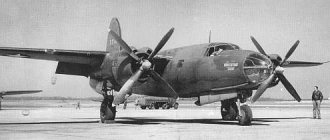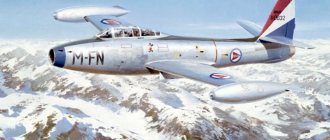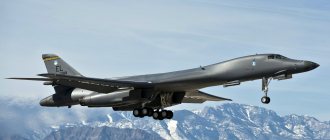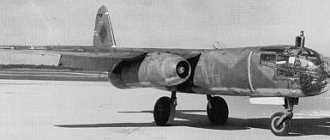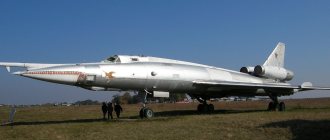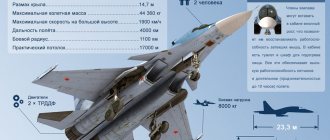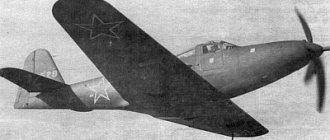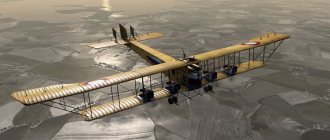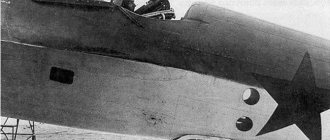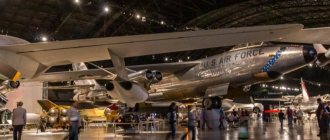The history of the Douglas TBD-1 "Devastator" bomber
A competition to create a torpedo bomber to replace the obsolete T3M and T4M aircraft was announced by the US Navy Bureau of Aeronautics in June 1934. Only two and Douglas, which had similar developments, agreed to participate in it, but this was clearly not enough, therefore both participating companies were asked to build prototypes.
"Great Lakes" was building a biplane, but "Douglas" decided to produce a new product - an all-metal deck-based monoplane. No one has ever done this in the USA before. Technically, the vehicle (the future TBD-1 bomber ) was quite interesting: it was on it that a hydraulic wing folding mechanism, a torpedo arrangement semi-recessed into the fuselage, and wheel brakes on the main landing gear were used for the first time.
The prototype XTBD-1 (X - experimental, in the USA) was built in the spring of 1935, and on April 15 of the same year, it first took to the air. Military testing began just 9 days later, at the Anacosta Naval Base.
Drawing of the Douglas TBD-1 Devastator bomber
Navy officials quickly became convinced that Douglas's innovations surpassed the Great Lakes "classics" in all respects. Just six months later (January 16, 1936), a new torpedo bomber, designated TBD-1, was adopted by the US Navy, and on February 3, a contract for the supply of 114 aircraft was signed. It is interesting that TBD-1 acquired its own name “Devastator” (“Destroyer”) only on October 1, 1941. Why the car, which was outdated by that time, was given such a pretentious name, history hides.
In just three years of production (1937-1940), 131 TBD-1 aircraft of all modifications were produced. It was used on all American aircraft carriers of that time (1 squadron each), planned for export to the Netherlands, but after the capture of this country by Germany, the project was closed.
American torpedo bomber Douglas TBD-1 "Devastator". The standard torpedo mount is quite original, don’t you think?
References
- Gunston 1976, p. 66.
- ↑ a b c
Winchester, Jim (2004).
"Douglas TBD Devastator."
Aircraft of World War II
(Aviation Information)
. Kent, UK: Grange Books plc. ISBN 1-84013-639-1. - ↑ a b
Monday 2006, p. 128. - Tillman and Lawson 2001, p. 56.
- Jackson and Doll 1973, p. 5.
- Tillman 2000, p. 82.
- Dive Bomber (1951)
- Doll 1967, pp. 7–8.
- ↑ a b
“USS Enterprise CV-6: The Most Decorated Ship of World War II, page 2.”
cv6.org
. Retrieved: April 11, 2010 - Cressman et al. 1990, p. 84–89.
- Parshall and Tully, 2005, pp. 206–215.
- Buell 1987, p. 494.
- "USS Enterprise CV-6: The Most Decorated Ship of World War II, page 3." cv6.org
. Retrieved: June 7, 2010 - Parshall and Tully 2005, pp. 215–216, 226–227.
- Doll 1967, p. 34.
- Ginter 2006, p. 91.
- Jackson and Doll 1973, p. 43.
- Champlin, Doug. "Douglas TBD-1". Archived May 22, 2011, at the Wayback Machine. nwrain.net
. Retrieved: April 11, 2010 - "Jaluit Ravager Lagoon Survey TBD, 2004." Archived May 9, 2007, at the Wayback Machine. tighar.org
. Retrieved: June 7, 2010 - 1998 Return to TBD page in "Douglas TBD-1 Wreck #0353." Archived September 28, 2007 at the Wayback Machine. nwrain.com
, 1998. Accessed June 7, 2010. - "To Save the Devastator: TBD Devastator Jaluit Lagoon Survey 2004, p. 2." Archived May 9, 2007 at the Wayback Machine. tighar.org
, 1997. Accessed June 7, 2010. - "The Holy Grail of Warbirds Found Off the Coast of San Diego." Archived December 17, 2011 at the Wayback Machine. eaa.org
. Retrieved November 21, 2011 - "Accident Report, TBD-1 BuNo.0377." Archived on June 9, 2012 at the Wayback Machine. eaa.org.
Retrieved: November 21, 2011 - Air International
, March 1990, p. 152. - Tillman 2000, p. 96.
Douglas TBD-1 "Devastator" bomber design and main modifications
The Douglas TBD-1 “Devastator” torpedo bomber is built according to the aerodynamic design of a cantilever low-wing aircraft. Truss fuselage. The wing is two-spar with folding consoles.
To keep the aircraft afloat in the event of a forced landing on water, rubberized inflatable bags were installed inside the wing (dismantled in 1940).
The landing gear is tricycle, partially retractable, with a tail wheel. The aircraft was equipped with landing flaps and a hook. All crew members were placed in one closed cabin, one after another. The top of the cabin was covered with a long canopy with 4 sliding sections.
The power plant consisted of a Pratt-Whitney R-1830-64 piston 14-cylinder radial air-cooled engine with a three-blade variable pitch propeller with a diameter of 3.12 m.
survivors
Devastator
not in any private, public or museum collection.
Many remains are being considered for restoration. Here are four aircraft wrecks that will most likely be recovered: TBD-1, BuNo. 0298 "5-T-7"
, ex-VT-5/USS Yorktown (CV-5), Jaluit, Islas Marshall.
[ 19 ] TBD-1 BuNo. 0353
Miami-Opa Locka Executive Airport, Oceano Atlantico, Miami, Florida.
[ 20 ] TBD-1 BuNo. 1515 "5-T-6"
ex-VT-5/USS Yorktown (CV-5), Jaluit, Islas Marshall.
[ 21 ] TBD-1 BuNo. 0377 "6-T-7",
ex-VT-2/USS Lexington (CV-2), Pacific, Mission Beach, California. [ 22 ] [ ]
Characteristics of Douglas TBD-1 "Devastator"
A country:USAType:BomberYear of issue:1935Crew:3 personsEngine:1x R1830-64 900 hpMaximum speed:331 km/h (205 km/h cruising)Practical ceiling:6000 mRange of flight:1134 km (with torpedo), 704 km (with bombs)Empty weight:2804 kgMaximum take-off weight:4473 kgWingspan:15.24 mLength:10.69 mHeight:4.59 mWing area:39.2 sq.m.Weapons:2x 7.69 mm machine gun (course-oriented, synchronized, 1000 rounds. turret, in the radio operator’s cabin, 600 rounds), up to 545 kg bomb load (or 1 Mk.XIII torpedo). Later, the front machine gun was replaced with a 12.7 mm (500 rounds), and the turret machine gun became 7.69 mm coaxial.
Modifications of Douglas TBD-1:
- XTBD-1 - prototype with a Pratt-Whitney XR-1830-60 engine producing 800 hp. Made in the spring of 1935. First flight April 15, 1935. Later used for engine testing.
- TBD-1 - serial, with a modified cockpit canopy shape, an oil cooler in the right wing console. In 1937-1939, 129 aircraft were manufactured.
- TBD-1A - (experimental) patrol bomber with a float landing gear, a 1200 hp Wright GR-1820-G105A engine, and an enlarged rudder. Designed for the Netherlands. Made in 1940 in one copy. Used for testing torpedoes at the Newport Torpedo Station.
Patrol bomber with float landing gear TBD-1A. Experimental.
New in blogs
Torpedo release.
Since the birth of combat aviation, the idea of using aircraft to destroy warships looked very tempting - after all, even the low speed that clumsy biplanes developed at the beginning of the century was enough to catch up with the fastest cruiser. Back in 1912, the American Rear Admiral Fiske patented a method of torpedo attacking ships from the air. And just two years later, specially created torpedo bomber aircraft were baptized by fire in the naval battles of the First World War.
By the early 1930s, torpedo bombers became the main weapon of aircraft carriers in US naval aviation. As a rule, these were biplanes with an open cockpit and a crew of three people - a pilot, a navigator-bombardier and a gunner. In addition to pure T-class torpedo bombers, special two-seat B-class naval bombers were also based on the decks of floating airfields under the Stars and Stripes flag. In the summer of 1934, the naval aviation command proposed the development of a universal carrier-based combat aircraft, designated “TV” (torpedo-bomber).
Three companies submitted their projects to the competition. The XTBG-1 brace biplane from Great Lakes looked the most conservative. The Hell vehicle looked completely different - their version of the XTBH-1 was a large twin-engine monoplane with a crew of four. However, the military chose the single-engine torpedo bomber XTBD-1 from Douglas and was the only one ordered to build the prototype. XTBD-1 was a very advanced development for its time. For the first time in the world, a carrier-based torpedo bomber was built according to the design of a cantilever monoplane with a closed cockpit. The design was all-metal with a semi-monocoque fuselage. The control surfaces were covered with canvas, and the duralumin skin of the wing, with the exception of the root part and tips, was corrugated (the only “relic” of the 20s).
The crew, consisting of a pilot, a navigator-bombardier and a gunner-radio operator, sat one behind the other in a common cockpit, covered by a long canopy with sliding sections. The main landing gear retracted back in flight, but the wheels did not turn around and half protruded in the retracted position. According to the designers, this cleaning scheme ensured greater safety during a forced landing on the fuselage. To improve aerodynamics, the tail wheel was initially recessed into the fuselage. But this was eliminated first on the prototype (so as not to complicate the design), and then on all subsequent aircraft.
An aircraft carrier requires good maneuverability when taxiing in a limited deck space, so the torpedo bomber received effective Bendix brakes on each wheel. And for stopping during landing there was a brake hook at the bottom of the fuselage in front of the tail wheel. Folding the wing on carrier-based aircraft had been used before, but on the XTBD-1 this process was mechanized for the first time using hydraulics. If on biplanes the wing boxes were pressed against the sides of the fuselage, then for a monoplane the option in which the consoles rose up and folded into a “tent” above the cabin looked more natural. The power plant chosen was a 900-horsepower Pratt Whitney XP-1830-60 air-cooled engine, rotating a three-bladed Hamilton Standard variable-pitch propeller with a diameter of 3.12 m. Two wing fuel tanks held 784 liters of gasoline.
In terms of small arms, they first planned to install two 7.92 mm Colt Browning M2 machine guns. One machine gun in the ring turret was controlled by a radio operator, defending the rear hemisphere. In a normal flight, this machine gun was recessed into the fuselage, and if necessary, the shooter opened special doors on top, moved his canopy section forward and took up defensive positions. The second machine gun, from which the pilot fired (using the Mk.III telescopic sight), stood in the fuselage in front of the cockpit on the right and had a synchronizer for firing through the propeller. Subsequently, with the beginning of combat operation, small arms were strengthened and on some aircraft a pair of Brownings was installed at the rear, and some aircraft had two large-caliber 12.7 mm barrels in front. In addition to the special aviation torpedo “Bliss Leavitt” Mk.XII (908 kg) with a length of 4.6 m and a diameter of 46 cm, it was possible to hang the outdated Mk.VIII from below the fuselage. On the sides of the torpedo mounting points there were two holders for a pair of 500 lb (227 kg) bombs.
Naturally, with this loading option, the torpedo was no longer installed. Underwing holders were provided for 12 small 100 lb (45 kg) bombs. When flying with a torpedo, the pilot used his telescopic sight, and during a bomb attack the navigator took over. He opened the doors of the Norden Mk.XV-3 automatic bomb sight from below the engine and pressed the “reset” button. The military had high hopes for the Mk.XV-3, because for the first time such a sophisticated sight was installed on a combat vehicle.
In general, the word “for the first time” can be used many times for a Douglas torpedo bomber. The XTBD-1 was the first US naval aircraft of all-metal construction, the first time it was designed to carry a purpose-built aircraft torpedo. With a span of 15.2 m and a take-off weight of more than 4.5 tons, XTBD-1 was also considered one of the largest “decks” created up to that time. Therefore, it is not surprising that the US Navy aviation command was eagerly awaiting the test results. In the spring of 1935, the first XTBD-1 prototype rolled out of the Santa Monica plant, and on April 15 it took off for the first time from Clover Field. Military tests took place at various naval bases. In Anacostia, naval aviation pilots performed evaluation flights, and night tests and torpedo drops were performed at the naval base in Dahlgren. In December, flights began from the aircraft carrier Lexington - in 5 days, three naval pilots made 13 landings on the deck using the arresting hook.
The maximum speed of the XTBD-1 without external suspensions was 322 km/h. If the flight was carried out with a torpedo, then the speed dropped almost twice to 200-210 km/h, and with bombs this figure was only slightly higher. The flight range with a torpedo and bombs reached 700 km and 1126 km, respectively, and the ceiling was 6000 m. Such data cannot be called very high, but for 1935 they were quite acceptable and significantly exceeded the characteristics of the TG-2 biplane torpedo bomber, which was intended to replace created XTBD-1. At the end of 1935, the first prototype returned to the Santa Monica plant, where a number of modifications were made to it according to the requirements of the military. The canopy has a new shape with large glass for improved visibility. The oil cooler air intake was moved from under the engine under the right plane, and the carburetor suction pipe was installed immediately behind the engine on the starboard side. We also developed a new tail unit with a smaller fin.
In January 1938, the leadership of the US Navy officially accepted the new torpedo bomber into service and in February signed a contract for the supply of 114 aircraft. The letter “X” denoting an experimental vehicle was no longer needed, and the TBD-1 index was left for production vehicles, adding in October 1941 the proper name “Devastator” (“Devastator” or “Devastator”) . And here the Douglas monoplane was the first, since before it the torpedo bombers of the fleet did not have names, limited only to an alphanumeric index. Serial TBD-1 received R-1830-64 engines of the same power 900 hp, but with a modified air duct system. With the installation of the necessary equipment, the empty weight of the aircraft increased from 2289 kg to 2540 kg compared to the prototype, and the maximum take-off weight was 4624 kg.
The first production TBD-1 took off on June 25, 1937 and made 65 test flights in less than two months. The first two production vehicles were left at the company for various tests, so deliveries to the fleet began with aircraft number 3. This significant event took place on October 5, 1937 on the deck of the aircraft carrier Saratoga, and by the end of the year the VT-3 division received all 18 required torpedo bomber staff. With the start of operation of the TBD-1, the shortcomings of the new aircraft began to emerge. The most serious of them turned out to be severe corrosion of the wing skin from exposure to sea salt, which is why damaged sheets had to be replaced every now and then. There were problems with the rudder linkages, and the brakes did not always work effectively under certain conditions.
In 1938, the new aircraft carriers Yorktown, Enterprise, Wasp and Hornet entered service - and all of them received Devastators. In 1940, the aircraft carrier Ranger replenished its aircraft fleet with a new torpedo bomber. One TBD-1 in 1940 became part of the VJ-3 multipurpose division, based on the Rigel floating workshop. And the Marine Corps Aviation Division VMS-2 in California used its Devastator as a target tow vehicle. The retraining from obsolete biplanes to TBD-1 was greeted by naval pilots with enthusiasm, but it was not without incident. Several planes have crashed because pilots began takeoff without ensuring that the wing was locked in the "unfolded" position. In the air, the Devastator, with its large-area wing, behaved excellently and had good maneuverability for its class. Effective flaps made it possible to maintain a landing speed of about 100 km/h, which made landing on the deck accessible even to inexperienced pilots. Much more criticism was caused by the unfinished and not entirely reliable torpedo Mk.XIII.
Due to losses during retraining, an additional batch of 15 TBD-1s had to be ordered in August 1938, and the last production torpedo bomber was handed over to the fleet in November 1939. The designers tried to expand the range of tasks of their aircraft, and in the summer of 1939 the very first production Devastator (remaining at the company) was equipped with 8.8 m long floats. However, the Navy showed little interest in such an aircraft, designated TBD-1A. The Americans know how to advertise their product, and an official request for the TBD-1A soon came from Holland - its aviation needed a maritime patrol bomber. The Dutch asked to make a number of changes to the design of the seaplane. The main condition was to replace the engine with a Wright GR1820-G105 (1100 hp) in order to unify the aircraft with the American Brewster B-339D Buffalo fighter already entering service. The designers have developed the appropriate documentation, and negotiations have already begun on the construction of the series. However, in May 1940, German troops occupied Holland, and all work on the TBD-1A had to be stopped. The only float-based Devastator remaining at the company was transferred to the 2nd Experimental Division in Rhode Island for various tests. He flew until May 1943 and participated in the development of the Mk.XIII torpedo.
Over the three pre-war years, the Devastator became the main carrier-based torpedo bomber of the US Navy. Intense training flights did not stop, and several times the aircraft took part in major naval exercises. During one of these exercises, TBD-1 of the VT-3 division from the aircraft carrier Saratoga practiced an air attack on the main base of the Pacific fleet in Pearl Harbor. The training attack with elements of surprise was very successful, but the Americans did not draw the proper conclusions. In December 1941, Japanese aircraft carriers chose exactly the same tactics, taking the battleships in Hawaii by surprise. By December 7, 1941, Devastators were based on seven aircraft carriers - Lexington (12 aircraft, VT-2 division), Saratoga (12 aircraft, VT-3 division), Yorktown (14 aircraft, VT-2 division). 5), Enterprise (18 aircraft, VT-6 division), Hornet (8 aircraft, VT-8 division), Wasp (2 aircraft, VS-71 division) and Ranger (3 aircraft, VT-8 division) VT-4). The fleet command used some of the torpedo bombers as training ones at the Pensacola base in Florida (the first 10 TBD-1s arrived here in 1938).
Before the start of the war with Japan, another innovation was introduced on the plane, equipping it with inflatable underwing floats. Thus, when landing the damaged TBD-1 on the water, the pilot had a chance to wait for help with the machine. True, some skeptics from the command were dissatisfied with this decision, believing that the enemy would have a much greater chance of capturing the secret Norden bomb sight. When Admiral Nagumo's squadron approached the Hawaiian Islands on December 7, 1941, there were no aircraft carriers in Pearl Harbor, thanks to which the main striking force of the US Pacific Fleet survived. The Devastators first flew on a combat mission on January 10, 1942, while the Lexington was on patrol near Hawaii. On this day, a pair of F2A-3 Buffalo fighters from an aircraft carrier discovered a Japanese submarine on the surface 160 km west of Johnston Atoll. The fighter pilots were ordered to maintain radio silence so as not to detect the carrier group, so the discovery was reported only after landing.
Almost two hours passed from the discovery before a pair of fighters and four Devastators with 325 lb (147 kg) depth charges took off. The Buffaloes again accurately reached the target area and the Americans were lucky - the submarine was still floating on the surface. First, the first pair of TBD-1s went into action, dropping depth charges from a height of 600 m. But the navigators were not helped by modern sights, and all the bombs fell far from the target, without causing any harm to it. The second pair of Devastators turned out to be more accurate, and the water columns of explosions rose 15 m behind the stern of the submarine. They tried to fire at the target with machine guns and fighter jets, but the boat immediately sank, and an oil slick spread on the surface. This gave rise to the Americans to claim that the submarine was seriously damaged, although the Japanese fleet did not report any losses that day.
In February 1942, an aircraft carrier force consisting of the Enterprise and Yorktown was tasked with conducting a patrol raid in the area of the Marshall Islands and the Gilbert Islands. The first to distinguish themselves on the long voyage were the Devastators of the VT-6 division from the Enterprise, sinking an armed Japanese trawler off Kwajalein Atoll and damaging seven more ships. Their colleagues from the VT-5 division were less fortunate, losing four vehicles during an attack on Japanese ships off Jalu Island. Two aircraft were shot down in air combat, and another pair of Devastators were forced to land on water due to lack of fuel, and their crews were captured.
In March 1942, Lexington and Yorktown conducted a successful operation against the enemy bases of Lae and Salamau in New Guinea. Here the losses of the Japanese fleet amounted to three ships, including a light cruiser. But the participation of the Devastators in the battle looks rather modest - the TBD-1 accounted for only one successful hit on a small transport with a displacement of 600 tons. This is due not only to the mistakes of the navigators, but also to the defects of the Mk.XIII torpedo, which, when colliding with the target, did not the fuse always went off. Nevertheless, the Devastators had no losses in New Guinea, and the fleet leadership continued to naively believe that planes could attack ships without fighter cover.
The next point in the combat career of the Devastators was the Coral Sea - it was here that, at the beginning of 1942, American and Japanese aircraft carriers first entered into battle with each other. The main goal of the fleet of the land of the rising sun was to capture Port Moresby, and Admiral Nimitz sent the Lexington and Yorktown to intercept the Japanese ships. The naval battle lasted for five days, and each side lost an aircraft carrier - the Americans Lexington, and the Japanese Soho. The losses of the Devastators in the air were small - only three aircraft, but all the vehicles from the Lexington that survived the air battles went to the bottom with it. After the battle, the pilots again harshly criticized the unfinished Mk.XIII torpedo. After being released and entering the water, the torpedo picked up speed too slowly, and the Japanese ships had time to maneuver and avoid being hit.
The turning point in the war in the Pacific Ocean was the Battle of Midway, the mention of which the Americans associate with the word “victory.” But for the pilots of the slow-moving Devastators, the word “Midway” sounds like a funeral march. In three days from June 3 to 6, divisions from the aircraft carriers Yorktown, Enterprise and Hornet lost 41 vehicles, and by the end of the battle only 5 torpedo bombers survived. “Devastators” became easy prey for Japanese “Zero” fighters, who, to the joyful cries of their sailors, shot with impunity vehicles weighed down by torpedoes.
Minoru Genda, the head of the operations department of the 1st Japanese aircraft carrier fleet, who observed the air battle from the aircraft carrier Akagi, managed to speak out on this matter. From the captain's bridge he could clearly see how the burning Devastators disappeared one after another into the waves, and Genda rejoiced: “We have nothing to fear from enemy aircraft, no matter how many there are!” Two torpedo bombers still managed to break through the fighter barrier and carry out a reset. But either in the heat of battle the American pilots missed, or the torpedoes failed again... Not a single Japanese ship was damaged. Upon exiting the attack, both vehicles were instantly shot down by interceptors.
But it was not in vain that the crews of the Devastators sacrificed themselves, and the joy of the Japanese was premature. The Japanese fighters were so engrossed in the dogfight with the torpedo bombers that they were unable to prevent a surprise attack by Dontless dive bombers. 37 dive bombers from the Enterprise attacked the aircraft carriers Kaga and Akagi, and 17 from the Yorktown targeted the Soryu. The bombs turned out to be more effective than torpedoes, especially since the decks of Japanese aircraft carriers were filled with aircraft ammunition that had been removed but not stored in the cellars. A few hits were enough for the aircraft carriers to burn like torches and soon sank to the bottom. The Japanese responded by sinking the Yorktown, after which they lost their fourth and final aircraft carrier, the Hiryu. At the same time, the Dontless dive bombers distinguished themselves again. The last combat operation in the Pacific Ocean TBD-1 was carried out on June 6, 1942, when the few surviving torpedo bombers from the Enterprise, together with dive bombers, attacked two Japanese cruisers Mikuma and Mogami damaged in the collision, managing to sink one of them. The monstrous, by American standards, losses of torpedo bombers at Midway completely and irrevocably undermined confidence in the Devastator. To this day, a “black legend” about this car is circulating in aviation publications, presenting it in the form of a “flying coffin.” But is this popular opinion among historians and aviation enthusiasts really so indisputable? Let's try to figure it out.
The torpedo bombers were launched into an attack in scattered groups without fighter cover against targets that had powerful air defense, and were also located at a distance almost prohibitive for the Devastators. The Japanese knew about the impending attack, which allowed them to concentrate a “curtain” of fighters at the right time and in the right place. In addition, the ill-fated Mk.XIII torpedo, in addition to low reliability, had too short an effective range and very strict restrictions on release (speed no more than 150 km/h, height up to 20 m). To have at least some chance of getting a hit, it was necessary to approach the target almost closely, at a distance of 450-500 m, under heavy fire from all types of weapons.
Everything taken together indicates that the crews of the Devastators were actually sent to be shot. By the way, the commander of the deceased VT-8 division, John Waldron, also understood this. His words before the fatal flight are known: “Guys, be prepared for the fact that few of us will survive. But even if only one breaks through, he must carry out the order!” Alas, no one succeeded. And not at all because of the supposedly worthless combat characteristics of the Devastator.
It is possible that they simply decided to blame tactical miscalculations of the command on the shortcomings of the aircraft. An indirect confirmation of this is the fact that a division of the newest Avenger torpedo bombers, just put into service, which took off from Midway on the same day to attack the Japanese squadron, exactly repeated the fate of the Devastators. Of the six vehicles, five were shot down, and not a single crew was able to even reach the target. But, one way or another, immediately after Midway, the verdict on the Devastator was signed, and the disgraced aircraft was hastily removed from service with the first-line units. Even before the events in the Coral Sea and Midway, Devastators appeared in the Atlantic. In March 1942, the aircraft carrier Wasp arrived at the main British naval base at Scapa Flow in the Orkney Islands. Two TBD-1s and Wildcats of VF71 flew from the aircraft carrier to Hutson Base. Wasp, leaving only one squadron of F4F-4 fighters for protection, went to Malta, delivering Spitfires there. A total of two such flights were carried out. The Devastators remaining on the shore, waiting for their aircraft carrier, also did not sit idle. From Hutson, two TBD-1s made several patrol flights to search for German submarines, providing passage for Allied convoys to Murmansk.
The Devastators from the USS Ranger remained in service the longest. This is explained by the fact that the Ranger's duty station was the relatively calm Caribbean Sea, where TBD-1s carried out patrol flights until August 1942. The demobilized torpedo bombers were then used as training bombers until the end of 1944. And after the end of their flying career, the decommissioned Devastators lived out their lives as teaching aids in aviation technical schools.
The aircraft's armament is a synchronized forward-facing 7.69 mm Browning machine gun, which was replaced with a more powerful 12.7 mm machine gun in later series of the aircraft. Both were installed on the right side of the aircraft, in front of the pilot's cabin. The ammunition load in the first case was 1000 rounds, and in the second - 500. In the radio operator's cabin, there was a 7.69-mm Browning machine gun on the turret with an ammunition load of 600 rounds. In later series The aircraft housed a coaxial installation of two similar machine guns.
Bomb armament included bombs weighing from 45 to 227 kg on underwing and ventral bomb racks. The latter could carry 45- or 147-kg depth bombs. An Mk.XIII aircraft torpedo weighing 908 kg was suspended under a special ventral unit.
During the sixty days between the Battle of Midway and the start of the Guadalcanal Campaign, all carriers with torpedo squadrons were re-equipped with TBF-1 Avengers, and their older aircraft, the TBD-1 Devastator, became history.
Operation of the Douglas TBD-1 "Devastator" bomber
At the end of 1939, TBD-1 torpedo bombers began to be used to search for German submarines in the Atlantic Ocean. Their first combat use took place on January 10, 1942, when 4 torpedo bombers from the Lexington aircraft carrier attacked a Japanese submarine with depth charges, but without much results.
In March 1942, TBD-1 sank a surface target for the first time, it turned out to be a small Japanese ship, and on May 7, 1942, during the Battle of the Coral Sea, the aircraft carrier Shoho was sunk with the participation of TBD-1. But already in June, during the battle at Midway Atoll, TBD-1 suffered heavy losses, without hitting a single Japanese ship.
Midway, the Destroyer's combat career ended; all aircraft were removed from service on carrier air wings, although they continued to be used in auxiliary areas and as training vehicles until mid-1944.
• Aviation Directory • Aircraft of the same period •
Source: compilation based on publicly available information on the Internet, as well as the book Land-Based Seaplanes of the Second World War 1939-1945. - Vol. 6. - M.: Aviam, 1995.
Related aircraft
VT-8 "T-16" (BuNo 1506, LCDR John C. Waldron, Horace F. Dobbs CRMP) takes off from USS Hornet, 4 June 1942. Twin 7.62 mm machine guns were unique to the VT-8. [25]
Similar aircraft
- Fairy Barracuda
- Great Lakes XTBG
- Grumman TBF Avenger
- Nakajima B5N
- Nakajima B6N
- Yokosuka B4Y
Notation sequences
- Sequence TB_D
(US Navy torpedo bombers, 1935-1946 (Douglas, 1922-1962)):
TBD
- TB2D
Bibliography
- Adcock, Al. TBD Devastator in action, aircraft number 97
. Carrollton, TX: Squadron/Signal Publications Inc., 1989. ISBN 0-89747-231-4. - Buell, Thomas B. The Quiet Warrior: A Biography of Admiral Raymond A. Spruance
. Annapolis, MD: United States Naval Institute Press, 1987. ISBN 978-0-87021-562-9. - Cressman, Robert B. et al. A Glorious Page in Our History: The Battle of Midway, June 4–6, 1942.
Missoula, MA: Pictorial Histories Publishers, 1990. ISBN 978-0-929521-40-4. - "Devastator... Not so destructive BTR-1." Air International
, March 1990, Vol. 38, No. 2. pp. 148–156. ISSN 0306-5634. - Dolan, Edward F. Jr. Hollywood goes to war
. London: Bison Books, 1985. ISBN 0-86124-229-7. - Doll, Thomas E. Douglas, TBD Devastator, Aircraft in Profile No. 171
. Leatherhead, Surrey, UK: Profile Publications Ltd., 1967. No ISBN. - Doll, Thomas E. SB2U Vindicator in action, board number 122
. Carrollton, TX: Squadron/Signal Publications Inc., 1992. ISBN 0-89747-274-8. - Drendel, Lou. US Navy carrier bombers from World War II
. Carrollton, TX: Squadron/Signal Publications Inc., 1987. ISBN 0-89747-195-4. - Ginther, Steve. Douglas TBD-1 Devastator, 71st Naval Fighter
. Simi Valley, CA: Ginter Publishing Company, 2006. ISBN 0-942612-71-X. - Gunston, Bill. Encyclopedia of the World's Combat Aircraft: A Technical Guide to Major Combat Aircraft from World War I to the Present Day.
New York: Chartwell Books, Inc., 1976. ISBN 0-89009-054-8. - Hardwick, Jack and Ed Schnepf. "Guide to Aviation Films." Making Great Aviation Movies
, General Aviation Series Volume 2, 1989 - Jackson, B.R. and Thomas E. Doll. Douglas TBD-1 "Destroyer", Aero Series 23
. Fallbrook, CA: Aero Publishers, 1973. ISBN 0-8168-0586-5. - Kinsey, Bert. US Navy and Marine Corps Aircraft of World War II, Part 1: Dive Bombers and Torpedo Bombers
. Northbrook, IL: Revell-Monogram, LLC, 2003. ISBN 0-9709900-5-7. - Lawson, Robert and Barrett Tillman. US Navy dive bombers and torpedo bombers from World War II
. St. Paul, MN: MBI Publishing Company, 2001. ISBN 0-7603-0959-0. - Mondy, David. "Douglas TBD Devastator." Hamlin's Concise Guide to American Aircraft of World War II.
London: Bounty Books, 2006. ISBN 0-7537-1460-4. - Nowicki, Jacek. Douglas TBD Devastator - SBD Dauntless (Wydawnictwo Militaria 119)
(in Polish). Warsaw, Poland: Militaria Publishing House, 2000. ISBN 83-7219-074-7. - Orriss, Bruce. When Hollywood Ruled the Skies: Classic World War II Aviation Films
. Hawthorne, CA: Aero Associates Inc., 1984. ISBN 0-9613088-0-X. - Parshall, Jonathan B., and Anthony P. Tully. The Shattered Sword: The Untold Story of the Battle of Midway
. Washington, DC: Potomac Books, 2005. ISBN 1-57488-923-0. - Taylor, John W.R. "Douglas TBD Devastator." Combat aviation of the world from 1909 to the present
. New York: G. P. Putnam's Sons, 1969. ISBN 0-425-03633-2. - Tillman, Barrett. "Come in and Strike!: The Navy's Last Combat Torpedo Bombers." Airpower,
Vol. 3, No. 4, July 1973 - Tillman, Barrett. TBD Devastator Units US Navy, Combat Aircraft Vol.
20 . Oxford, UK: Osprey Publishing, 2000. ISBN 1-84176-025-0. - Tillman, Barrett, and Robert L. Lawson. US Navy dive bombers and torpedo bombers from World War II.
St. Paul, MN: MBI Publishing Company, 2001. ISBN 0-7603-0959-0. - Winchester, Jim. "Douglas TBD Devastator." Aircraft of World War II
(Aviation Information). Kent, UK: Grange Books plc, 2004. ISBN 1-84013-639-1.
See also[edit]
VT-6 TBD dropped a torpedo in October 1941.
Aircraft of comparable role, configuration and era
- Douglas XTB2D Skypirate
- Fairy Albacore
- Great Lakes XTBG
- Grumman TBF Avenger
- Nakajima B5N
- Nakajima B6N
- Yokosuka B4Y
Related Lists
- List of World War II aircraft
- List of United States military aircraft (Navy)
- List of United States military aircraft
